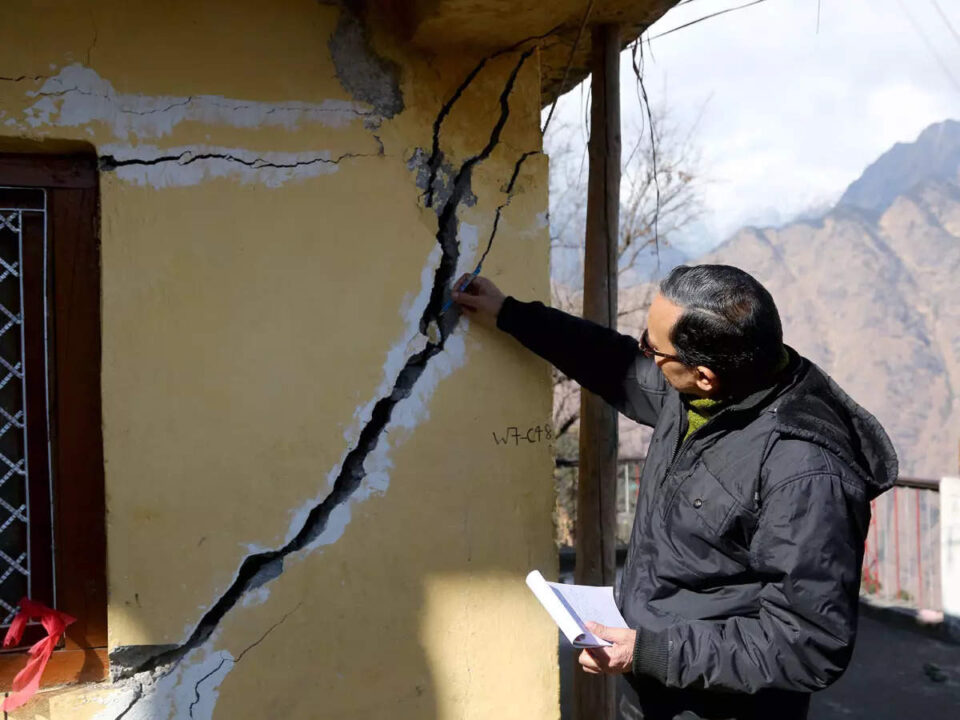
JOSHIMATH, Uttarakhand: The number of houses developing cracks due to incidences of land subsidence rose to 849 on Tuesday, January 17, while this number was only 150 in the first week of December 2022.
First incident of houses developing cracks was reported from the Gandhinagar area of Joshimath in October 2021, when 14-15 houses developed cracks. On January 4, 2023, the district administration in Chamoli issued a bulletin calling the situation as ‘crisis’ for the first time. Bulletin said that a total of 561 houses have developed cracks.
As per the latest bulletin issued on Tuesday, a total of 800 buildings, including houses and hotels, have developed cracks. The number of houses in the danger zone has also increased to 167. As of January 10, only 86 houses were in the danger zone.
Local authorities decided to demolish the structures declared ‘unsafe’ by the Central Building Research Institute (CBRI) including Malari Inn and Mount View. But demolition could not go on due to protests over the issue of compensation for demolished structures and loss of livelihood. The protesting crowd is also demanding closure of the National Thermal Power Projects (NTPC), the alleged culprit behind the incidents of land subsidence. The Joshimath Bachao Sangharsh Samiti (JBSS) has also announced holding a protest across the town on Republic Day on January 26.
In the meantime, the authorities reported that two more hotels have started tilting towards each other, and cracks have widened in hotel Comet and Snow Crest hotel.
In terms of ward-wise distribution of affected houses, Ravigram has reported having 161 such houses, and in Gandhinagar, there are 154 such houses. Authorities say that they have evacuated a maximum number of people from Gandhinagar, Sindhar, Manohar Bagh, and Sunil wards as most of the houses fall in the ‘danger zone.’
Land subsidence has also affected the upper and lower portion of the tehsil buildings, thereby scaring people. To closely monitor the situation, CBRI has installed crack meters in the affected buildings.
Himanshu Khurana, District Magistrate, Chamoli, said that the authorities identified 615 rooms in 83 places which will be used as temporary relief camps for the 2,190 evacuated people of the Joshimath town area. In addition to that, 491 rooms in 20 buildings have also been identified for use as temporary shelter facilities in Pipalkoti outside the municipal area, where 2,205 people will be housed. The district has distributed a relief package worth ₹3.77 crore to 396 families affected by the land subsidence crisis. The relief items distributed to the affected people include 284 food kits, 360 blankets, 842 litres of milk, 55 heaters or blowers, 36 daily use kits and 642 other items.
When the demolition activity resumed on Sunday, January 15, the hotel owner Thakur Singh Rana said, “The district administration teams have demolished the topmost floor of my hotel and they are working to demolish the other floors on Tuesday.”
Ajendra Ajay Badrinath Temple, Chairman of the Temple Committee, on Monday, January 16, visited the winter abode of Lord Badrinath, named Narsingh temple and said that there is no threat to the building. He said, “I inspected the Narsingh temple premises and have been monitoring the situation in the past too. Currently, there is no danger to the temple premises apart from a few cracks that developed earlier outside the temple premises.”
He added that the Geological Survey of India (GSI) also surveyed the temple and they are awaiting their inspection report.

